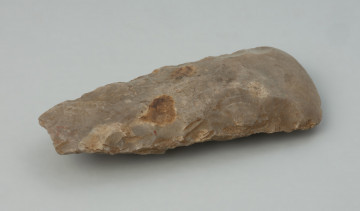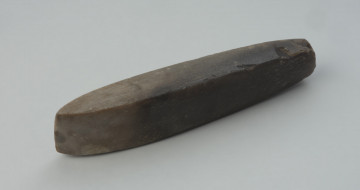
Flint axe
National Museum in Szczecin
Part of the collection: Stone Age
In 1876, the landowner Schemel from Duchowo (Germann: Duchow, now a part of Police) donated to the Szczecin Society for History and Antiquities of Pomerania (Gesellschaft für Pommersche Geschichte und Altertumskunde) archaeological findings that had been discovered on a sandhill near his estate. The donated objects included a goblet decorated with cord impressions, fragments of another earthenware vessel, an axe made of diorite, two hatchets, a knife fragment and flint axes (płoszcze). In the archaeological terminology, the name płoszcze is sometimes used to describe flint products resembling arrowheads or blades of some types of polearms, lance weapons or spiked weapons. The presented monument functioned in older literature as a fragment of a dagger or a javelin arrowhead. More recent studies identify with a part of the so-called dagger sceptre, the blade of which was set transversely in a handle made of organic material. Sceptres with a flint blade are interpreted as imitations of copper forms. They are considered insignia of power, prestige objects or ceremonial accessories, similar to the bronze sceptres widespread in the Early Bronze Age. The pottery and rock artefacts discovered at Duchowo probably formed an assemblage and were part of the furnishings of a destroyed pit grave without a stone structure. The assumption was already made in the first published mention of the find. However, doubts were raised by the presence of charcoal and ruminant bones at the discovery site, which may indicate the existence of a settlement here. However, it has not been established whether the animal bones have any connection with the find of vessels and stone artefacts or whether they are from another period. The inventory of the presumed grave can be connected to the Late Neolithic circle of cultures with ceramics decorated with cord impressions, and chronologically can be related to the period between the end of the 1st and the beginning of the 2nd half of the 3rd millennium BC.
Krzysztof Kowalski
Author / creator
Dimensions
cały obiekt: height: 15.6 cm, width: 3.6 cm
Object type
thrusting weapon
Technique
pressure carving, carving, hand made
Material
flint, stone
Origin / acquisition method
acquisition
Creation / finding place
Owner
National Museum in Szczecin
Identification number
Location / status

National Museum in Szczecin

National Museum in Szczecin

National Museum in Lublin
DISCOVER this TOPIC
Museum of King Jan III's Palace at Wilanów
DISCOVER this PATH
Educational path